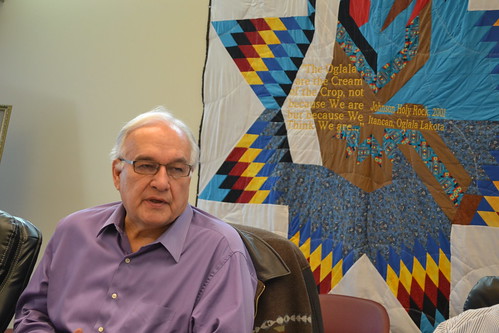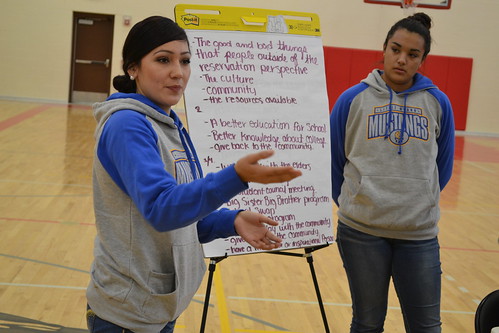
Recently USDA Rural Development staff in South Dakota spent two days at the Pine Ridge Indian Reservation, home of the Oglala Sioux, where they met with Tribal leaders, educators and other Federal partners. They made this trip as part of a broader administration effort to change the way the federal government works with communities. This approach values residents’ knowledge of their communities’ strengths and needs; it also includes local leaders as essential partners and collaborators.
Jennifer Irving, Director of Regional Equity for Thunder Valley Community Development Corporation, a local non-profit intimately involved in one-such effort at Pine Ridge said, “It is important to coordinate engagement of the Promise Zone stakeholders to ensure that Tribal Leadership’s vision and priorities are being met while optimizing Tribal commitment of time and resources.”
Pine Ridge was designated a Promise Zone last April and in July a Presidential Disaster Declaration was received following severe summer storms. Since then the federal government, the Oglala Sioux Tribal government, and local organizations, such as Thunder Valley and other key partners have been working collaboratively to ensure activities, investments, and projects of the many entities across the reservation have broad-based community support and coordinated, and likely to yield results for residents.

Visiting Rural Development staff were given an overview of the wide array of work underway including the Tribe’s work on a proposed Tribal Planning Office and a Comprehensive Economic Development Strategy (CEDS) that will lay out a long term vision for developing a stronger economy for Pine Ridge. Other topics covered included recovery efforts underway in partnership with the Federal Emergency Management Agency (FEMA) recovery efforts and an overview of the work two local organizations, Mazaska and Lakota Funds, are doing to identify housing and other finance-related needs.
At Oglala Lakota College we met with President Shortbull who talked about work underway to develop an Ag Expo Center that would be instrumental in making local food a path for economic development. The College has already raised a substantial amount toward the expected total project need.

This project will create educational opportunities in the community by increasing training and hands on experience for producers of all types of agricultural production on Pine Ridge. It will expand their economic opportunities by providing a place where producers can work in a commercial kitchen or work with large animals in a modern facility. This project has broad public support and holds significant potential for the Tribe and people living at Pine Ridge.
While at Pine Ridge we also heard directly from Oglala Sioux youth at a roundtable with high school students at Little Wound School. Of all of the meetings over the course of the two days, this opportunity to connect with the students at Little Wound that really hit home. The stories of hope, struggle and the students’ passion inspired us even more with the work ahead.
Persistent poverty and lack of infrastructure investment have taken their toll at Pine Ridge. Now, these placed–based efforts aims to leverage investments, increase economic activity, improve educational opportunities and improve the quality of life in the area through focused work on the six goals the community has identified as instrumental to improve the economic health of the area, increase the quality of life and accelerate the work to create comprehensive community revitalization.
First, accelerate job creation by building the foundation for new businesses including implementation of workforce development programs to ensure people are trained with the skills to fill new positions.
Second, increase economic activity by addressing economic issues at the systemic level—like expanding increasing banking options and affordable housing for the workforce on the Reservation.
Third, improve educational opportunities on the Reservation from primary school through the post-secondary level by offering Lakota immersion education, charter school options and opportunities at the Oglala Lakota College.
Fourth, improve public safety Reservation by addressing substance abuse issues and strengthening the justice system.
Fifth, provide affordable, low maintenance, energy efficient housing for residents of the Reservation, focusing on key issues like affordable rent, homeownership and middle income housing by developing the real estate market and increasing access to capital.
Sixth, systematically develop infrastructure by providing the Tribal government with the ability to operate, maintain, and replace current infrastructure and facilitate future development.

The Promise Zone Initiative is part of the President’s plan to partner with local communities, businesses and Tribes to create jobs, increase economic security, expand educational opportunities, increase access to quality, affordable housing and improve public safety. To date, thirteen Promise Zones have been designated across the country; Pine Ridge is one of only two Tribal Promise Zones. Seven more Promise Zones will be designated in 2016 and applications are currently being accepted.
We know that increasingly, the community where a child grows up in impacts her odds of graduating high school, her health outcomes, and her lifetime economic opportunities. The Administration has been steadily embarking on a different approach to working with communities to ensure where a child is born never determines her destiny.
The Promise Zone Initiative is one of the Administration’s community-based initiatives in action across the country. In these places federal experts are working side by side with residents and local leaders to create customized solutions; bolstering coordination across agencies and improving how we interact with communities as a ‘one Government’ partner; and relying on valuable data to help inform solutions and evaluate what’s working and what’s not.
The Promise Zone designation enables USDA to work more collaboratively with other federal agencies in partnership with the Oglala Sioux and others across the Pine Ridge Indian Reservation on efforts to increase economic mobility and create opportunities across the entire region. To view all active community-based initiatives in your community, visit www.whitehouse.gov/omb/place.




